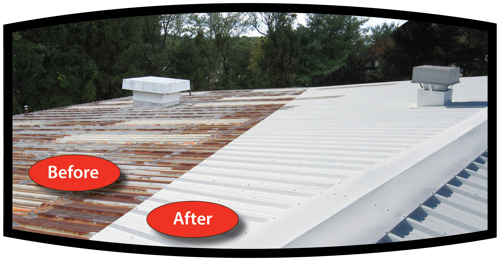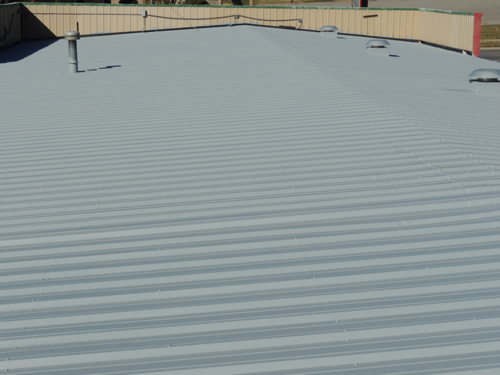Industrial-Strength Roof Coating Systems Offer Longer Life For Aging Metal Roofs

|
George Furman |
By George Furman, Product Manager for Asphalt and Waterproofing, Firestone Building Products
Metal is one of the more practical and widely-used roofing materials on the market today. Introduced as an alternative to roofing materials such as clay and wood, metal roofs can last between 40 and 70 years. However, when one has reached the end of its lifecycle, building owners are left with very few options.
Replacing a metal roof comes at a high price. Researchers from Carnegie Melon University estimate the average replacement cost of a commercial roof ranges from $215 - $3231 per square meter. For large structures like luxury resorts, casinos and stadiums, this could mean millions of dollars in materials and labor. It’s a tough choice for building owners and facility managers, as a significant investment in infrastructure maintenance can detract from the ability to invest in other areas.
In addition, an aging roof system increases the risk of failure, damage to the building envelope and damage to the building contents. These damages can lead to unplanned costs when repairing leaks or other maintenance issues. Fortunately, there is a cost-effective solution: Fluid-applied roofing systems.

|
After prepping, the new elastomeric roof goes on in spray-form. Pigment can be added to make the spray a specific color but white is popular because it adds to the roof's energy efficiency. |
A Cost-Effective Alternative to Replacing a Metal Roof
A fluid-applied roofing system can extend the life of a metal roof, repair leaks and also contribute to energy savings. These systems involve cleaning and preparing the existing metal roof surface, applying a primer and then applying a coat or coats over the entire surface.
With the proper preparation and application, an industrial-strength roof coating system – such as the type offered by Firestone Building Products – can extend the life of a metal roof for an additional 10 years.
Two of the most common types of fluid-applied roofing systems are aluminum coatings and elastomeric coatings. These materials are well suited for metal roofs due to their adhesion and elongation properties. Both materials adhere well to metals and the elongation allows the coating to expand and contract with the metal as temperatures fluctuate throughout the year.

|
The before and after difference in the roof's appearance is remarkable. |
Elastomeric Coatings vs. Aluminum Coatings
For a more cost-effective solution to seal and protect metal roofs, aluminum coatings are more common in industrial and agricultural buildings and, in some cases, can even be installed directly over light rust. With a metallic color, the coating assures a high level of reflective properties that keep the roof near ambient air temperatures.
Elastomeric metal roof coatings, such as the system offered by Firestone Building Products, are formulated with a 100 percent acrylic polymer that can provide durability, greater adhesion and water protection, while improving both the lifecycle and appearance of buildings. The white coating minimizes stress to fasteners and seams caused by thermal expansion and contraction. Additional colors like gray, tan and black can also enhance the appearance of the roof.
Deciding between an aluminum coating and elastomeric coating is primarily an aesthetic choice between an aluminum color and the more varied color options offered by elastomeric coatings. In cases where roofs have existing coatings on them, adhesion testing is a critical step to ensure the proper material is used for maximum adherence.

|
The finished roof looks as good as new. |
A new coating can also reflect the sun’s energy away from the roof’s surface more efficiently, therefore reducing the temperature transferred through the building envelope. In the summer, this keeps a building cooler with less heat soaking in from the sun and, in the winter, traps warm air below the surface.
The Firestone Aluminum Coating and Industrial Elastomeric Metal Roof Coating can help reduce the roof’s surface temperatures and peak cooling demands by up to 15 percent.2 Additionally, both systems are also ENERGY-STAR-approved and may be eligible for tax and utility credits.
Prep, Seal, Coat
An important advantage of restoration versus replacement is the installation process. Re-roofing projects can displace building occupants during construction, disrupting daily activity. Utilizing a fluid-applied roof system to an existing metal roof allows inhabitants to remain in the building during installation without disturbance.
Installation techniques can be remembered in three easy steps: prep, seal, coat.3
The most vital task when applying a fluid roof system is preparing the existing metal surface. Without the proper preparation techniques, adhesion of the coating can be greatly compromised.
The existing roof surface must be cleaned by intensive power washing that removes oils, grease, moisture, sealant, caulk or loose debris. Installers should then reattach any loose panels to create a flush surface and then dry the entire surface thoroughly. All horizontal and vertical seams, as well as holes with a diameter that is not greater than a ¼ inch can be sealed with seam tape. For seaming around roof units or irregular shaped penetrations, a polyester fabric and patching cement (3-course method) can be used.
To further protect against corrosion, contractors should apply a rust inhibitive primer, and then apply the coating by brush, roller or spray as specified by the manufacturer.
About the author: George Furman is the product manager for asphalt and waterproofing at Firestone Building Products. In this role, all facets of management with Firestone Building Products asphalt-based product lines are his responsibility. After graduating from Eastern Illinois University, George worked with several commercial roofing contractors prior to joining Firestone Building Products. Since that time he has held management positions in warranty claims, sales, technical services, information technology and marketing.
1 http://www.cmu.edu/gdi/docs/life-cycle-costs.pdf
2 http://firestonebpco.com/roofing/metal-roofing-systems/fluid-applied-metal-roofing-systems/firestone-aluminumcoating/
http://firestonebpco.com/roofing/metal-roofing-systems/fluid-applied-metal-roofing-systems/industrial-elastomericmetal-roof-coating/
3 https://www.youtube.com/watch?v=Ti3ZdPj25sY&feature=youtu.be
About Holcim Building Envelope Division
 Holcim Building Envelope produces a broad range of exterior building products, including the Elevate™ (formerly Firestone) lineup of metal roof and wall panel systems. To learn more, visit or www.holcimelevate.com.
Holcim Building Envelope produces a broad range of exterior building products, including the Elevate™ (formerly Firestone) lineup of metal roof and wall panel systems. To learn more, visit or www.holcimelevate.com.